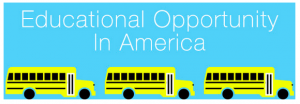Education Drives Expanded Access to Opportunity in the U.S.
 •
•
September is a time for optimism. As millions of students head back to school, their parents are filled with hope that their children will learn, build skills, make friends and ultimately be better off than the generation that came before.
But today, the American Dream is at risk for far too many of our nation’s youth. Teens and young adults are facing unemployment rates twice the national average as well as widening income inequality. Nearly six million 16-to-24 year olds are currently disconnected from school and work. Does this mean that our optimistic outlook for today’s young Americans is misguided? Not at all.
In fact, dramatic gains in education have propelled overall growth in access to opportunity over the past four decades, helping to offset economic downturns such as the Great Recession. This reinforces the importance of education as one of the most powerful paths to the middle class and economic prosperity as a nation.
According to the Historical Report of Opportunity, released by Opportunity Nation and Measure of America, educational opportunity has soared by 80 percent since 1970. The Report defines Educational Opportunity as the number of children in preschool, the number of high school students who graduate on time, and the number of adults with at least an associate’s degree. Massachusetts improved the most over the four decades in these measures; Nevada, the least. In particular, the data show significant increases in preschool enrollment and post-secondary attainment.
Between 1970 and 2010, the number of 3- and 4-year-olds enrolled in both public and private preschool increased nearly four-fold, underscoring a growing awareness about the academic, social and emotional benefits of early childhood education. Studies have shown that low-income children who attend high-quality preschool are more successful academically, more likely to graduate from high school and enroll in postsecondary education, and experience lower rates of negative outcomes such as incarceration and teen pregnancy. While some states have cut funding for public pre-K in recent years, early childhood education continues to be a priority for most states and enjoys bipartisan support. But we must do more to ensure all children have access to high-quality early childhood education regardless of where they are born.
In addition, every state in the country experienced positive growth in the percentage of adults aged 25 or older who completed an associate’s degree or higher — an indication of the changing global economy that demands higher levels of education and training of workers. From 1970 to 2010, the percentage of Americans with at least an associate’s degree increased by 105 percent.
Washington D.C. leads the nation in both the number of children enrolled in pre-kindergarten and the number of adults with at least an associate’s degree. While the District of Columbia may not be able to claim credit for the latter (many highly educated workers flock to the nation’s capital), and it still has work to do on its public education system (the on-time high school graduation rate lags well behind the national average), it can rightly boast about its decision to invest heavily in expanded access to early childhood education.
Nearly 70 percent of 3- and 4-year-olds in D.C. attend pre-kindergarten, the largest percentage in the country. This is no accident. In 2008, D.C. residents approved landmark legislation that gave every child the right to attend a high-quality preschool. In 2010 and 2011, they approved an estimated $112 million for local preschool programs, a good portion of which went to better training for early childhood educators. As a result of these investments, about 13,000 of the city’s 15,000 3- and 4-year olds now attend public preschool.
In contrast, just 28 percent of children nationwide were enrolled in state-financed preschool in 2012 — the same amount as the previous year. And only 36.3 percent of Americans have at least an associate’s degree, even though economists predict that by 2020, two-thirds of American jobs will require some form of post-secondary degree or credential. So, though we’ve seen a major surge in the attainment of post-secondary credentials, we must quicken our pace if we are to build a 21st-century workforce and equip more people with the skills required to earn family-sustaining wages.
We still have a long way to go to make sure that all Americans, particularly youth, receive the economic, educational and community supports they need to thrive and embark on meaningful careers. However, the data from the Historical Report of Opportunity confirms the importance of education as a critical pathway to upward mobility and our country’s economic health. It justifies the optimism we feel each fall as our children board the school bus or we drop them off at college, even as it reminds us that a lack of equity in educational opportunities still plagues many of our communities. If we want to make progress more rapidly over the next 40 years, we will have to work together to build strong ladders of opportunity in every state and every zip code.
Read more at The Huffington Post.









